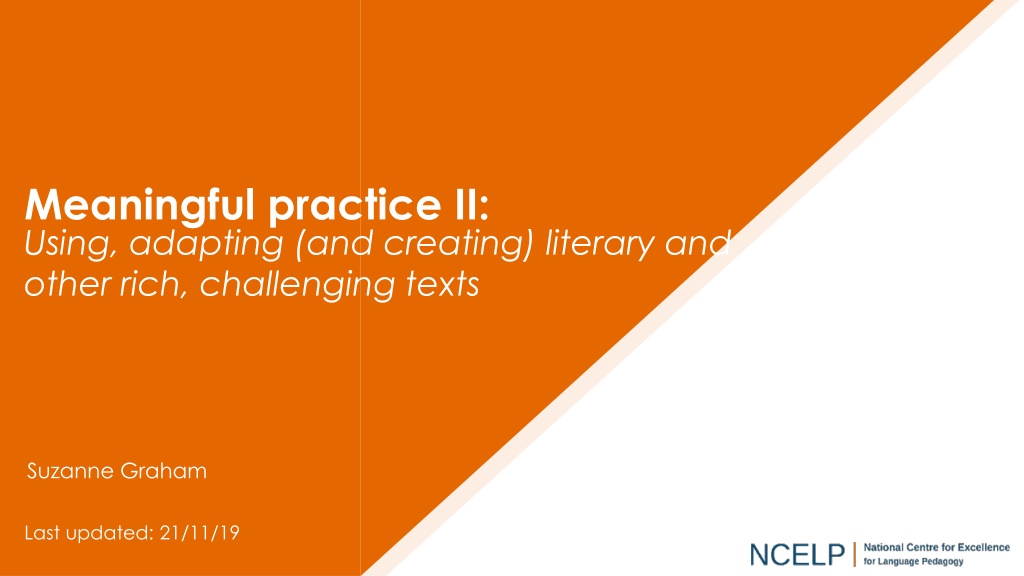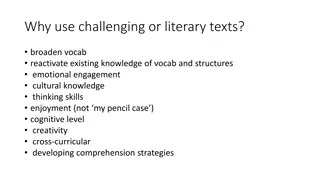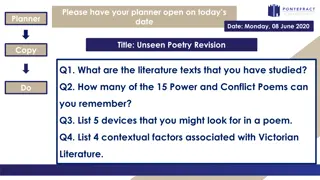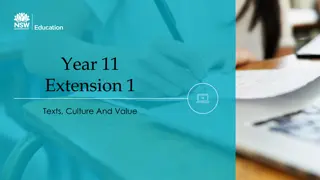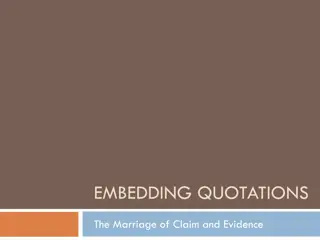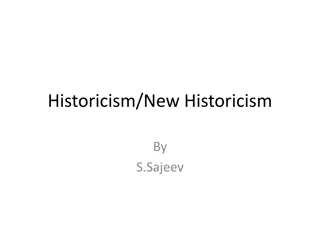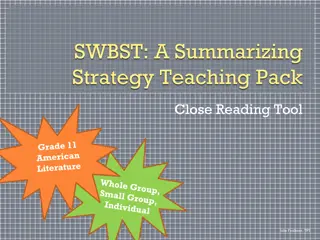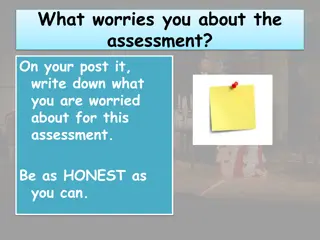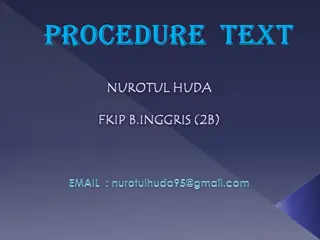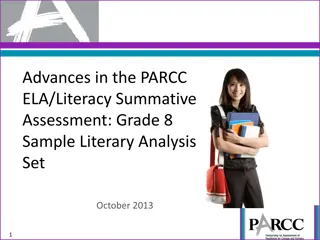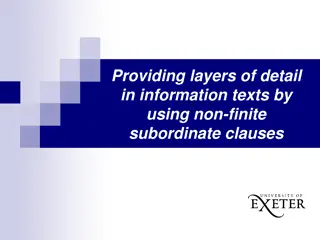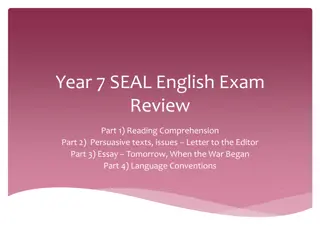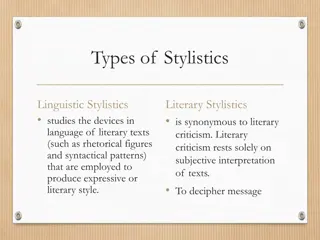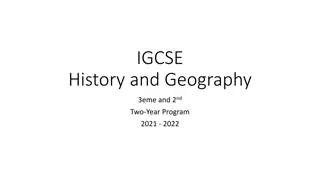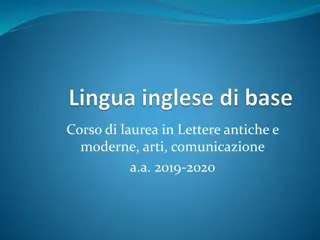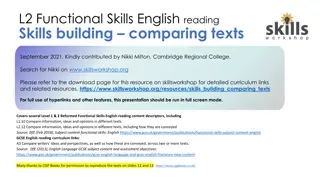Exploring the Use of Literary Texts in Language Teaching
Delve into the rationale and effectiveness of incorporating literary and challenging texts in language learning. Understand the impact on L2 development, key considerations for successful use, and available research evidence.
Download Presentation

Please find below an Image/Link to download the presentation.
The content on the website is provided AS IS for your information and personal use only. It may not be sold, licensed, or shared on other websites without obtaining consent from the author. Download presentation by click this link. If you encounter any issues during the download, it is possible that the publisher has removed the file from their server.
E N D
Presentation Transcript
Meaningful practice II: Using, adapting (and creating) literary and other rich, challenging texts Suzanne Graham Last updated: 21/11/19
Literary and other rich, challenging texts Why use them and how?
Key questions addressed in the session What is the rationale for using literary and other challenging texts? Does the use of such texts lead to improved L2 learning? If so, in what ways? Under what circumstances? What are the outcomes? What are some of the conditions for effective use of literary and other challenging texts? Summary and ways forward for my own classroom
Pedagogy Review The content taught through the new language should be stimulating and widen pupils knowledge of the culture, history and literature of speakers of the new language, without compromising the necessary sequencing of vocabulary and grammar. Pupils should be taught to pay attention to the detail of meaning through translation, and should extend the range of their vocabulary and understanding through reading short texts and literature. Teaching Schools Council 2016. Modern Foreign Languages Pedagogy Review. A review of modern foreign languages teaching practice in key stage 3 and key stage 4. (Chair: Ian Bauckham). Teaching Schools Council.
Discuss What might we include in literary and challenging texts ? In your opinion, is it important to use literary texts in your teaching? Why/why not? Are literary and challenging texts used much in your school? If so, how successfully? In your school, how far do learners: (a) develop language and language skills from using literary texts; (b) enjoy reading literary texts; (c) have the necessary skills to comprehend literary texts?
The research evidence available about using literary and other challenging texts National Curriculum (2014), new GCSE and A levels now emphasise use of authentic texts, including literary sources But, impact of using such materials on schoollearners motivational and language development has received little research attention (Paran, 2008) Most studies focus on adults, and on motivation rather than language development What kind of text? Almost no studies compare literary or authentic texts with more functional texts (Ellis & Shintani, 2014; Paran, 2008) How to use the texts? Researchers agree that how texts are used is crucial, but debate the most appropriate form of deployment (Paran, 2008) e.g., does a language or a personal focus have most benefits?
Rationale (1) Motivation culture & interesting content Lack of interest and low self-efficacy predict dropping MFL (Graham, 2002) Learners motivated by intrinsic interest, including interest in L2 culture (Fisher, 2001; Graham, 2002, 2004, 2018; Graham et al., 2016) Primary to secondary transition can see less focus on L2 culture and this transition phase also associated with reduced intrinsic motivation (Graham et al., 2016) Personal relevance , perceptions of lessons and ease of learning key for choosing to study a GCSE (Taylor and Marsden, 2014) Can using literary or challenging texts increase personal relevance, perceptions and sense of achievement? If we want England s children to get better at reading and to do more of it, we have to give them a diet that is attractive, nutritious and satisfying. Restricting them to an unbalanced diet, the thin gruel of a phonics-dominated approach, is a recipe for lowering standards and turning children against the written word. ( ) Children certainly need instruction in the techniques, but they only become effective and committed readers through reading texts that interest them (Dombey, 2010:13)
Rationale (2) Motivation - affect & emotions Emotions and enjoyment closely linked (Dewaele, Witney, Saito, & Dewaele, 2017) Self-efficacy for expressing thoughts and feelings and understanding authentic materials predict taking a language GCSE (Graham, 2018) Literature and authentic texts provide opportunities for emotion, empathy, intercultural understanding and creativity (Duff & Malley, 1990; Malley, 1989), and so lead to more interaction (Kim, 2004) but not always! (Donato & Brooks, 2004; Nguyen, 2016) How literary and authentic texts are used is crucial (Ellis & Shintani, 2014; Paran, 2008) the emotional component is too often ignored, resulting in relatively emotion-free (and therefore often boring) classroom sessions ( ) that require little emotional investment and therefore little potential for unpredictability, outbursts, surprise, risk-taking, embarrassment, anxiety ... and enjoyment. Dewaele, 2015, p.13
Discuss What about learning outcomes? What is learnt through using literary or authentic texts? Handout 1: Research summary Paran (2008)
Linguistic outcomes Study by Maxim (2002) Method. Beginner learners of German in a US university (after four weeks of daily study). One group read a novel together in class across 10 weeks. A control group studied simpler textbook readings. Assessed through departmental exams and pre-test and post-test. Findings. The literature group did as well as the control group on most tests, including vocabulary. Limitations. University learners; impact on oral proficiency not assessed
Linguistic outcomes Study by Woore et al. (2018) Method. Year 7 learners read semi-authentic French texts One group received phonics instruction ; another comprehension strategies instruction , a third just read the texts . Findings. Reading comprehension gains: for all three groups; Vocabulary gains: small - medium for the Strategies group, medium - large for Phonics group; Reading aloud: medium-sized gains for phonics groups. Limitations. No combined phonics/strategies group. Effects did not last when learners reverted to normal texts. Additional studies look at impact of literature on interaction (Kim, 2004), grammar (Yang, 2001), and intercultural understanding (Scott & Huntington, 2002)
Rationale(3) Incidental vocabulary learning through reading and listening ( picking up words when reading for whole meaning) Vocabulary learning can result from extensive reading and listening, but for this to happen (Ellis & Shintani, 2014): 1. Learners need large amounts of input 2. The input needs to be comprehensible and linguistically rich 3. Learners need to pay attention to new linguistic forms in the input (p.190) 4. There has to be mental and motivational involvement (Huang et al., 2012; Laufer & Hulstijn, 2001)
Incidental vocabulary learning (contd) amount of words Extensive reading & listening does not necessarily improve breadth - isn t very reliable way of picking up new words BUT incidental learning does develop depth (shades of meaning, collocations, etc.) strengthen existing knowledge (meet words more times, in different contexts) Incidental learning can be improved via high involvement intentional learning tasks and multimodal input (e.g. reading while listening, if text and audio are synchronised at word level). Enhancing noticing of words during reading and listening can help, especially if learners have to attach meaningto the word (can t skip it) Training learners in how to work out meaning from context helps them benefit further from extensive reading (Schmitt, 2008)
Noticing features essential for learning, but benefits from help Poetry offers language input which is foregrounded, unusual, and draws attention to itself (Hanauer, 2001: 298). Since many features of L2 input are likely to be infrequent, non- salient, and communicatively redundant, they may go unnoticed unless attention is drawn to them (Laufer & Girsai, 2008: 697). Der Panther, Rainer Maria Rilke Im Jardin des Plantes, Paris Sein Blick ist von Vor bergehen der St be so m d geworden, da er nichts mehr h lt. Ihm ist, als ob es tausend St be g be und hinter tausend St ben keine Welt Recall from the Grammar CPD, the importance of noticing and attaching meaningfulness to the content!
Rationale (4): Increasing the Involvement Load (Laufer and Hustijn, 2001; Huang, Willson, & Eslami, 2012) The retention of words depends on the degree of involvement in processing these words. The amount of involvement load depends on: Need. How necessary is it to know this word to complete the task? How much does the learner need or really choose to do the task? Recall from previous CPD the idea of task essential Search. How hard does the learner have to work to find the meaning of the word? Recall from previous CPD the idea of desirable difficulty/challenge Evaluate. How much does the learner have to think about how to use this word in different contexts or about different aspects of its meaning? Recall from previous CPD the idea of meeting the same language in multiple contexts
What does this look like in practice? Different involvement loads which is the higher in each case? Need (1) teacher requires learners to use a particular word from a text in a sentence (2) learner is interested to look up the meaning of an unknown word in a dictionary while reading a story Search (1) A learner works out a word s meaning by looking for clues in the words that come before and after it (2) A word s meaning is provided as a gloss in the margin Evaluate (1) After reading, learners complete a gap-fill based on the text, choosing from a set of words, which permits guess work (2) After reading, learners write a paragraph to express their feelings about the passage, choosing some of the words from the text
Another example When did Philippe make the famous tightrope walk? Philippe Petit Journal Intime Je m appelle Philippe Petit. J ai 24 ans. Je suis un magicien, jongleur et funambule fran ais. Voici un extrait de mon journal intime. Le jeudi 8 ao t 1974. Tr s t t le matin, nous relions les deux tours avec un c ble de m tal .. How old was he at that time?
Example of working with challenging texts with Year 9 learners: Linguistic creativity in language learning Approx. 600 Year 9 learners of French & German We explored the impact on: (Graham et al, ongoing; Hofweber & Graham 2017) Learners development in reading, writing and vocabulary and creativity Learners motivation for and beliefs about language learning Teachers used either (1) non-figurative, factual texts OR (2) literary texts containing figurative language Both text-types contained similar difficulty of language and addressed similar themes e.g. love, death, migration, otherness All teachers used the text types in both (1) functional and (2) creative ways
Two approaches to working with texts Creative approach Aim: generate personal involvement ( need ), attention on emotional content, metaphor / conceptual level present images concept-level activation ask about emotions images evoke give picture story + ask them to order it with focus on emotional state Learners read text while listening, focusing on expression of emotion through intonation present images concept-level activation Functional approach Aim: generate factual information processing, attention on form / functional level ask about events / facts images convey give picture story + ask them to order it with focus on sequence of events Learners read text while listening, focusing on sound-spelling correspondences
Key findings: Challenging texts can help vocabulary and pupils enjoy the texts French: For both text types, learners increased vocabulary size by around 300 words on average, Benefits depended on text type, teaching approach, and learners prior attainment Creative approach led to greater increases in reported confidence in reading French and German: No differences in overall enjoyment of literary versus factual texts Attitudes to different texts varied widely Some evidence that learners of French preferred creative activities; learners of German preferred functional activities! Literary texts led to increase in creativity, but factual texts did not
Discuss Look at the sample set of activities for exploiting the text L homme qui te ressemble Try to identify how they seek to heighten involvement , engagement , and noticing See also Handout 4 for a summary of ideas
Summary so far Literary and other challenging texts can be used successfully with KS3 learners, with benefits for vocabulary Different approaches and text types needed to suit different learners Activities that prompt personal, emotional and imaginative responses need to be used along with focus on vocabulary and grammar Pre, during and post-reading and listening activities need to maximise involvement : Need (make language task essential and the task intrinsically interesting)) Search (establish desirable difficulty/challenge in terms of grasping word meaning) Evaluate (make judgements about language when using it in different contexts)
Key questions What is the rationale for using literary/authentic texts? Does the use of such texts lead to improved L2 learning? If so, in what ways? Under what circumstances? What are the outcomes? What are some of the conditions for effective use of literary and other challenging texts? Summary and ways forward for my own classroom
Some conditions for effective use of challenging texts: Learning how to comprehend As well as linguistic knowledge, comprehending involves: the ability to engage in a range of strategic processes while reading more challenging texts (including goal setting, academic inferencing, monitoring) ( )the ability to engage in reading, to expend effort, to persist in reading without distraction.. (Grabe & Jiang, 2013, p.4)
Ability to understand & respond to written & spoken texts Reading and listening proficiency Self-efficacy Linguistic knowledge Monitoring outcomes Strategic behaviour Goal- setting Vocabulary knowledge Grammar knowledge Phonological decoding: ability to pronounce words Attributing causation Adapting behaviour Self- evaluating Self-regulated learning Adapted from Canale & Swain, 1980 Zimmerman, 2002
Simpler text and/or learner with greater linguistic knowledge Comprehension of text Linguistic knowledge Strategic behaviour More challenging text and/or learner with less linguistic knowledge Comprehension of text Strategic behaviour Linguistic knowledge
How do KS3 learners read challenging texts? Erler (2003) Guess from the pictures what it's all about Invent a meaning Scan for words that look like English and try to guess the meaning of the text from them The above strategies can be counterproductive if overused and used in isolation Absence of monitoring: Go back to a word or section and double-check that it makes sense
Is it useful to teach comprehension strategies? What is the research evidence? Evidence of benefits but many studies are with older, more proficient learners (Ardasheva et al., 2017; Plonsky, 2011, 2019; Taylor, 2014) For a review of many studies: see OASIS summary Plonsky (2011) School-aged learners in England Macaro and Erler (2008) (Handout 7) Recent larger-scale study: FLEUR project, Woore et al. (2018)
When texts are linguistically challenging, strategies can be taught and be helpful Text engagement strategies Guess from words around problem word Think hard about words I might know (i.e. don t give up easily) Use a process of deduction ( it can t be that because .. ) Use common sense (prior knowledge) Remember to read the whole sentence to see if it makes sense Sound out the word or phrase (Macaro & Erler, 2008)
Strategy combinations and self-regulation were vital we would claim that the readers who had undergone strategy instruction were now better orchestrators of the strategies at their disposal Macaro & Erler (2008, p. 114) Bottom-up strategies = knowledge and understanding of vocabulary and grammar Combinations of top-down and bottom- up strategies need to be brought to the attention of learners and they should be encouraged to use and evaluate these combinations for their effectiveness Top-down strategies = using your general knowledge (e.g., what is this likely to mean?) Macaro & Erler (2008, p. 116)
French Language Education: Unlocking Reading (FLEUR) Woore et al. (2018) All groups made similar gains in reading comprehension. Using challenging texts helped reading comprehension. Experimental study (Randomized Control Trial) Pre-, post-, delayed post-test design c. 900 students in 36 schools nationally Intervention phase lasted 16 weeks, c.25 minutes per week Interventions delivered by usual class teachers Phonics Strategy instruction Challenging texts Challenging texts Challenging texts Phonological decoding Reading comprehension Vocabulary Self-efficacy Strategic behaviour Motivation Teachers / students views
Greatest improvement in self-efficacy(= reported confidence in own ability) for reading challenging texts for learners starting Year 7 with low general academic attainment and low French attainment High attainers: Self-efficacy score (out of 24) Low attainers: Self-efficacy score (out of 24) 19 18 15 17 14.5 16 14 13.5 15 13 14 12.5 13 12 12 Strategies Phonics Texts Strategies Phonics Texts Time 1 Time 2 Time 1 Time 2 Graham et al. (in progress)
Text engagement regulatory reading strategies
Key questions What is the rationale for using literary/authentic texts? Does the use of such texts lead to improved L2 learning? If so, in what ways? Under what circumstances? What are the outcomes? What are some of the prerequisites for effective use of literary/authentic texts learning to comprehend; Summary and key questions for my own classroom
Pause for reflection! Talk to the person next to you about the ideas so far.
Summary of key points from research (1) Literary and other challenging texts can be beneficial for KS3 learners benefits for consolidating vocabulary (e.g., when vocabulary has been met previously) Along with focus on grammar, vocabulary & phonics, activities that also prompt personal, emotional & imaginative responses are beneficial Different approaches and different text types suit different learners Pre-, during and post-reading and listening activities need to maximise involvement : create a need, create a challenge, create opportunity to use in other contexts
Summary of key points from research (2) Teaching a small number of text engagement, regulatory strategies for comprehension can benefit self-efficacy (belief in one s ability) and hence improve persistence with challenging texts Self-efficacy (self-reported confidence) of lower attaining learners may benefit from comprehension strategy instruction, when compared to higher attaining learners Phonics teaching important for exploiting challenging texts including sounding out words to help access meaning
Key ways forward for own practice What do you consider to be the next steps for your own classroom, in respect of using literary and other challenging texts? Some questions: How (a) competent (b) confident are my students at reading and understanding literary and other challenging L2 texts? Which approaches to using literary texts would work best in my classroom? How do I need to vary the approach according to the age / stage of learners? How can I best prepare learners? At which points in my SOW might I use literary texts? How can I monitor and record progress in comprehension and use this information to inform my teaching?
Key questions What is the rationale for using literary and other challenging texts? Does the use of such texts improve L2 learning? If so, in what ways? Under what circumstances? What are the outcomes? What are some of the conditions for effective use of literary & other challenging texts learning to comprehend; Summary and ways forward for my own classroom
References Ardasheva, Y., Wang, Z., Adesope, O.O., & Valentine, J. C. (2017). Exploring effectiveness and moderators of language learning strategy instruction on second language and self-regulated learning outcomes. Review of Educational Research, 87, 544 582 DOI: 10.3102/0034654316689135 Dewaele, J.-M. (2015). On emotions in foreign language learning and use. The Language Teacher, 39, 13 15 http://discovery.ucl.ac.uk/10019165/ Dewaele, J.-M., Witney, J., Saito, K. & Dewaele, L. (2017) Foreign language enjoyment and anxiety in the FL classroom: The effect of teacher and learner variables. Language Teaching Research. DOI: 10.1177/1362168817692161 (online first). Dombey, H. (2010). Teaching reading: What the evidence says. Leicester: UKLA Donato, R. & Brooks, F. (2004). Literary discussions and advanced speaking functions: Researching the (dis)connection. Foreign Language Annals, 37, 183 199.. Duff, A., Maley, A. (1990). Literature. Oxford: Oxford University Press Ellis, R. , & Shintani, N. (2014). Exploring language pedagogy through second language acquisition research. New York, NY and London, UK: Routledge Erler, L. (2003). Reading in a foreign language. Near-beginner adolescents experiences of French in English secondary schools. Dphil Thesis, Oxford University. Fisher, L. (2001) MFL recruitment post-16: The pupils' perspective, Language Learning Journal, 23, 33-40. Grabe, W., & Jiang, X. (2013). Assessing reading. The companion to language assessment (185-200). Wiley. DOI: 10.1002/9781118411360 Graham, S. (2002). Experiences of learning French: A snapshot at Years 11, 12 and 13. Language Learning Journal,25, 15-20. 10.1111/j.0026-7902.2004.00224.x Graham, S. J. (2004). Giving up on modern foreign languages? Students perceptions of learning French. The Modern Language Journal, 88, 171-191. Graham, S. (2018). Motivation for language learning in times of change: A study of adolescent learners of French and German. Paper presented at the BAAL Language Learning and Teaching SIG annual conference, University of Southampton , July 2018. Graham, S., Courtney, L., Tonkyn, A., Marinis, T. (2016). Motivational trajectories for early language learning across the primary-secondary school transition. British Educational Research Journal, 42/4, 682 702. doi:10.1002/berj.3230 Graham, S., Fisher, L., Hofweber, J., Kr semann, H., & Zhang, A. (ongoing). Linguistic creativity in language learning. Part of Creative Multilingualism, funded by the AHRC. Graham, S., Woore, R., Porter, A., Courtney, L., & Savory, C. (in progress). Navigating the challenges of L2 reading: Self-efficacy, self-regulation and individual differences. Hanauer, D. (2001). The task of poetry reading and second language learning. Applied Linguistics, 22, 295-323
References Hofweber, J., & Graham, S. (2017). Linguistic creativity in language learning: Investigating the impact of creative text materials and teaching approaches in the second language classroom. Scottish Languages Review, 33, 19-28 https://www.scilt.org.uk/Portals/24/Library/slr/issues/33/33-02%20Hofweber-Graham.pdf Huang, S., Willson, V., & Eslami, Z. (2012). The effects of task involvement load on L2 incidental vocabulary learning: A meta-analytic study. The Modern Language Journal, 96, 544-557 DOI: 10.2307/23361715 Kim, M. (2004). Literature discussions in adult L2 learning. Language and Education 18.2, 145 166 Laufer, B., & Hulstijn, J. (2001). Incidental vocabulary acquisition in a second language: The construct of task-induced involvement. Applied Linguistics, 22, 1-26 Laufer, B.,& Girsai, N. (2008). Form-focused instruction in second language vocabulary learning: A case for contrastive analysis and translation. Applied Linguistics 29(4): 694-716. Maley, A. (1989). Down from the pedestal: Literature as resource. In Literature and the learner: Methodological approaches. Cambridge: Modern English Publications Maxim, H.H. (2002). A study into the feasibility and effects of reading extended authentic discourse in the beginning German language classroom. The Modern Language Journal, 86, 20-35 Nguyen, H.T.T. (2016). How does an interactive approach to literary texts work in an English as a foreign language context? Learners' perspectives in close-up, Innovation in Language Learning and Teaching, 10, 171-189, DOI: 10.1080/17501229.2014.932361 Paran, A. (2008). The role of literature in instructed foreign language learning and teaching: An evidence-based survey. Language Teaching, 41, 465-496. Scott, V. M., & Huntington, J. A. (2002). Reading culture: Using literature to develop C2 competence. Foreign Language Annals, 35, 622-631 Schmitt, N. (2008). Review Article: Instructed second language vocabulary learning. Language Teaching Research, 12(3), 329-363. doi: https://doi.org/10.1177/1362168808089921 Taylor, F. & Marsden, E. (2014). Perceptions, attitudes, and choosing to study foreign languages in England: An experimental intervention. The Modern Language Journal, 98(4), 902-920. doi: https://doi.org/10.1111/modl.12146 Yang, A. (2001). Reading and the non-academic learner: A mystery solved. System, 8, 450 460.
